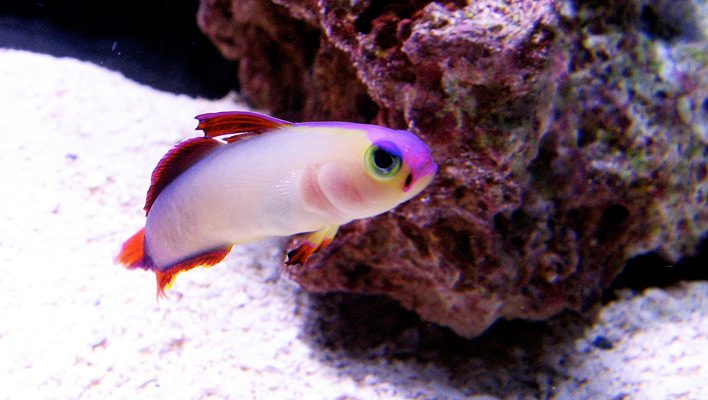You’ve spent the long dollar on a gorgeous marine fish with the hopes that it will bring new life and interest to your tank, but then it refuses to reveal itself for more than a passing glimpse. What could be more aggravating? Worse yet is the specimen that seems to disappear completely, giving you that little “heart attack” all hobbyists experience when they suspect a specimen has jumped out of the tank or been eaten.
Why do fish perform this maddening vanishing act and cause such consternation for the hobbyists who care for them? Actually, there are several reasons a fish may “go to ground,” some more or less worrisome than others. Here, in no particular order, are five of them:
#1 It’s the new fish on the block
Newly introduced fishes—even individuals of notoriously bold species—almost invariably go into hiding in the rockwork upon arriving in their new home. (Burrowing species, including certain wrasses that bury themselves in the substrate when frightened or sleeping, will very literally go to ground until they get settled.) It can take anywhere from a matter of hours to days or even weeks before new fish feel comfortable enough in their new surroundings to emerge on a regular basis.
When a new fish seems to have disappeared, it can be powerfully tempting to overturn all the rockwork to ensure the specimen is still alive, but this just adds stress on top of stress to the already harried fish. Stay calm and patient, and you can usually rest assured the specimen will emerge in its own good time.
#2 It’s being bullied
This can happen either to a newcomer or to an established specimen after a troublemaking tankmate is introduced. Sometimes the bullying will work itself out; other times it won’t. In the latter case, the victim will be in a continual state of stress, which can lead to compromised disease resistance, and may be too frightened to even go after its share of food, weakening it further.
It’s incumbent upon the hobbyist to observe his or her livestock closely for signs of such aggression and, if it doesn’t resolve, to rehome one of the specimens in order to restore peace.
#3 It’s ill
A normally active, outgoing fish suddenly going into hiding can be a sign that the specimen has gotten sick or is suffering due to out-of-whack environmental conditions. If this should occur, check all your water parameters (specific gravity, pH, temperature, etc.) and test the ammonia, nitrite, and nitrate levels to make sure they’re all in the desired ranges. Closely monitor the specimen (to the extent possible with it trying to stay out of sight) for physical or behavioral symptoms of disease, and be prepared to move it to a hospital tank for treatment if appropriate.
#4 It’s naturally nocturnal
As one might expect, species that are naturally active at night, such as the various cardinalfishes, will tend to stay hidden during daylight hours in aquariums—which isn’t particularly conducive to viewing by diurnal hobbyists. In this situation, a little creative aquascaping to provide a variety of ledges, overhangs, and front-facing caves will help enhance your viewing opportunities. Also, incorporating moonlighting into your illumination scheme will allow you to observe the natural behaviors of nocturnal species.
#5 It’s naturally nervous
Some species, for example the firefishes or the marine bettas, are just timid by nature and prone to hiding whenever any sort of threat is perceived. To encourage such “nervous Nellies” to reveal themselves more often, be sure to provide ample hiding places and retreats (this may sound counterintuitive, but it will actually bolster their confidence); keep them only with peaceful, non-boisterous tankmates; and try to avoid situating their tanks in areas that are prone to a lot of human activity.



